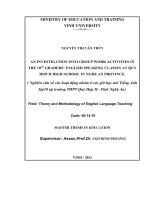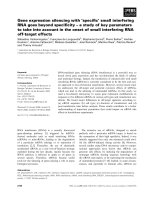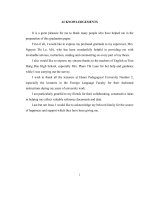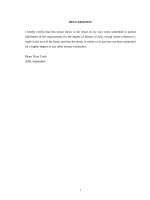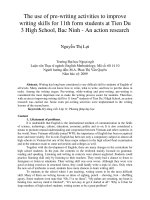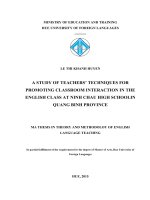A STUDY OF TEACHING ACTIVITIES TO PROMOTE CLASSROOM INTERACTION IN ENGLISH SPEAKING CLASSES AT TRAN HUNG DAO HIGH SCHOOL IN QUANG BINH PROVINCE
Bạn đang xem bản rút gọn của tài liệu. Xem và tải ngay bản đầy đủ của tài liệu tại đây (519.06 KB, 93 trang )
MINITRY OF EDUCATION AND TRAINING
VINH UNIVERSITY
NGUYEN THI MAI
A STUDY OF TEACHING ACTIVITIES TO PROMOTE
CLASSROOM INTERACTION IN ENGLISH SPEAKING
CLASSES AT TRAN HUNG DAO HIGH SCHOOL IN
QUANG BINH PROVINCE
MA THESIS IN THEORY AND METHODOLOGY
NGHE AN, 2017
NGUYEN THI MAI
A STUDY OF TEACHING ACTIVITIES TO PROMOTE
CLASSROOM INTERACTION IN ENGLISH SPEAKING
CLASSES AT TRAN HUNG DAO HIGH SCHOOL IN
QUANG BINH PROVINCE
MA THESIS IN THEORY AND METHODOLOGY
OF ENGLISH LANGUAGE TEACHING
CODE: 60.14.01.11
SUPERVISOR: Assoc. Prof. Dr. NGO DINH PHUONG
STATEMENT OF AUTHORSHIP
I certify that the thesis entitled “A study of teaching activities to promote classroom
interaction in English speaking classes at Tran Hung Dao High School in Quang
Binh province” is the result of my own work. The data and findings discussed in the
thesis are true, used with permission from assistants and have not been published
elsewhere.
Vinh, August 2017
Author’s
signature
Nguyen Thi Mai
l
ABSTRACT
This study aims to examine the use of teaching activities of teachers to
promote classroom interaction in English speaking classes at Tran Hung Dao High
School in Quang Binh province and how the teaching activities affect classroom
interaction. The study employed both quantitative and qualitative research
methods.The data were collected from 9 teachers and 80 students at Tran Hung Dao
High School in Quang Binh province by the research instruments: questionaire and
interview. The result showed that the most teachers and students were aware of the
importance of classroom interaction in English speaking classes. Through using
teaching activities for promoting classroom interaction, teachers created an
interactive atmosphere in classroom and made students more comfortable and
confident in English speaking classes.
From the findings, the research has sought to provide practical implications for
using teaching activities to improve classroom interaction and overcoming
difficulties they encounter when using activities for promoting classroom
interaction. Limitations and suggestions for further researches were also carried out
to draw more persuasive and reliable conclusion.
li
ACKNOWLEDGEMENTS
I would like to put on my thanks and sincere appreciation to the encouragement
and support of many individuals in assisting me to accomplish this study.
First of all, I would like to express my sincere gratitude to my supervisor,
Assoc. Prof. Dr. Ngo Dinh Phuong, for his unaccountable guidance, support, help
and patience.
Second, my gratefulness extended to all the other lecturers of College of
Foreign Languages, Vinh University for teaching me and for their guidance and
valuable evaluation in approving the innital proposal for this thesis.
Third, I gratefully wish to thank all my colleagues and my students at Tran
Hung Dao High School in Quang Binh province for their help and supporting me
during the time I carried out this study.
Finally, I would also like to thank my parents, my older brothers, my older
sister, my younger sister and my friends. Their encouragement and supports have
been strong motivating forces for me to conduct this thesis.
TABLES OF CONTENTS
Contents
Pages
CLT
EFL
Communicative language teaching
English as a foreign language
ESOL
FL
English for Speakers of Other
Languages
English teaching and learning
processes
Foreign language
N
Number
SL
%
Second language
Percentage
ETALP
7
CHAPTER I
INTRODUCTION
This chapter is presented with the purpose of giving the rationale. Then, the aims and
the research questions of the study are stated. This is followed with the scope of the
study, an overview of research methodology and finally introduces the outline of the
study.
1.1.
Rationale
For recent decades, the English language has been the common language of
the world. It is spoken as a second language (SL) and an official language in many
countries, and millions of people speak English as a foreign language (EFL).
According to Ramelan (1992:2-3) English as an international language is used to
communicate, to strengthen and to fasten relationship among all countries in the
world in all fields, for example in tourism, business, science, technology, etc.
Therefore learning and teaching English are getting more and more important to nonnative nations of English. Vietnam is not an exception. English is taught in Vietnam
as a compulsory subject at schools.
There are many factors that cause the students’ difficulties in learning foreign
language. One of them is the method given by the teacher. Creating an environment
that engages students in the learning process is not always easy. Teaching EFL
requires the use of the effective learning method. It means that a set of procedures or
the techniques in teaching have an influence on the student’s learning result.
Furthermore, most students today are bored with the traditional teaching method.
They need a new method which can motivate them into learning foreign language.
Therefore, teachers look for a significant method to help learners to use this language
for communication. The communicative language teaching (CLT) is considered as
the best method for such purpose. Johnson ( 1995 ) claims that “classroom
communicative competence is essential in order for the second language students to
participate in and learn from their classroom experience.” In CLT theory, interaction
8
is one type of its frameworks. Classroom interaction is one of the important means in
classroom. Interaction is occurred every day in class activities between teacher and
his students. Besides, the interaction between the teacher and the students is an
essential part of teaching and learning processes. Moreover, Tsui (1995) stated that:
“Classroom language and interaction are even more important because language is at
once the subject of study as well as the medium of learning. When the students listen
to the teacher’s instruction and explanations, when they express their views, answer
questions and carry out the tasks and activities ...”. In fact, with a better
understanding of classroom interaction processes, teachers may improve the quality
of their teaching and improve students’ learning. In teaching and learning EFL, there
are four important skills. Those are reading, listening, writing and speaking.
Speaking is defined as an interactive process of constructing meaning that involves
producing, receiving and processing information. Its form and meaning are
dependent on the context in which it occurs, the participants, and the purposes of
speaking (Burns & Joyce, 1997). Speaking is one of the basic skill of foreign
language teaching and learning processes. It provides learners with the opportunity
to hold successful conversation as well as manage interaction, and it is very
necessary for students to learn. The teaching of EFL speaking has been closely
connected to CLT theory. In process of learning, classroom activities have a central
role for helping the students interact and improve their speaking skill. Many
researchers and teachers agree that students learn speaking skills best through
“interacting”. To achieve effective classroom interaction, it depends on the given
teaching activities. Teacher should look for suitable activities for his lesson to get
effective classroom interaction in English speaking classes.
Being a teacher of English at a High School in Quang Binh province, I find that
the speaking lesson is the most challenging one to both the teachers and the students.
In fact, a lot of students revealed that when speaking English they usually encounter
many discouraging difficulties. It is difficult for students to communicate with their
teacher and friends. The students do not want to express their ideas and interact with
9
their friends and teacher. They are always in shyness. Therefore, Teaching activities
are essential if the teachers want to help their students speak more fluently, using
effective activities is one of the ways to help them feel more motivated and selfconfident in speaking lessons. The above reality is the main motivation which helps
the author to decide to carry out the research: “ A study of teaching activities to
promote classroom interaction in English speaking classes at Tran Hung Dao
High School in Quang Binh province”. I thus wish conduct this research to find
out the ways the teacher creates classroom interaction in English speaking lessons as
well as suggest effective activity to promote classroom interaction in English
teaching and learning processes (ETALP).
1.2.
Aim of the study
This study aims to explore the use of teaching activities of teachers to promote
classroom interaction in English speaking classes at Tran Hung Dao High School in
Quang Binh province. It also examines the effect of teaching activities on classroom
interaction in English speaking classes.
1.3.
Research questions:
To achieve the aim of the research, this study is going to find out the answers
to the following questions:
1. What are the teaching activities that teachers currently use in the English
speaking classes to promote classroom interaction at Tran Hung Dao High
School in Quang Binh province?
2. What are the effects of teaching activities on classroom interaction in the
English speaking classes?
1.4.
Scope of the study
This study was conducted with the participants are 9 teachers of English and 80
students in grade 10. The study focuses on using teachers’ techniques to promote
classroom interaction in English speaking classes at Tran Hung Dao High School in
Quang Binh province and find out the effects of teaching activities on classroom
interaction.
1
0
1.5.
Method of the study
Nine teachers of English and two classes at Tran Hung Dao High School will
participate in the study. The students and teachers will be invited to complete the
questionnaires designed for them regardless of their gender. However, due to time
limitation, the research could be carried out only with 80 students not specializing in
English and 9 teachers of English. The main instruments for data collection include
questionnaires and interviews.
1.6.
Organization of the Study
This research consists of five chapters which are briefly described in a
review of their contents. Chapter I, Introduction, includes rationale for
the study, the aims, methods, scope, and design of the study. Chapter II,
Literature review, refers to review of previous studies, theoretical
concepts relevant to using teachers’ techniques to promoting classroom
interaction in English speaking classes. Chapter III, Methodology,
presents the study and these include, research questions, participants,
material, procedures and results. Chapter IV, Research findings and
discussion, describes, analyzes and discusses the results of the data.
Chapter V, conclusions and recommendations, a conclusion of the study,
the limitations and implications of the study, and suggestions for further
research are also mentioned in the last chapter
1
1
CHAPTER II
LITERATURE REVIEW
This chapter presents theoretical background relevant to the topic such as the
definition of classroom interaction, types of classroom interaction, the roles of
classroom interaction. Besides, it provides principles for teaching speaking, the
outline of a speaking lesson, classroom speaking activities. It focuses specially on
the use of teaching activities to improve classroom interaction in English speaking
classes and the effect of teaching activities on classroom interaction.
2.1.
Classroom interaction
In recent years, classroom interaction has been considered as an important
strategy in the field of education. According to Rivers (1987:4), part of the teacher
art is to create, or stimulate students creation of, the types of situation in which
interaction naturally blossoms and in which students can use for actual
communication what they have been learning in a or formal fashion. In this way,
they are already engaging in the central activity for which languages is used in
human relation. In fact, interaction occurs everyday in teaching and learning process
and plays an important role in teaching language communication. It depends on
everyone inside classroom, not only by the teacher in the classroom, but also the
students. In EFL classroom, teacher plays a very important role because he conducts
teaching-learning process and motivates the learners who do not have motivation.
Therefore, the teachers’ methods in language classroom are really significant. This
helps his students to interact with others effectively in ETALP. The purpose of the
language classroom interaction is for giving everyone the best possible opportunities
in learning language.
2.1.1.
Definition of classroom interaction
The concept of interaction is defined as “reciprocal events that require at least
two objects and two actions. Interaction occurs when these objects and events
naturally influence one another” (Wagner, 1994 : 8 ). The communicative
processinvolves interaction between at least two people. It do not occur only from
one side. Ellis and Foto (1999 : 9 ) mention, “Interaction contributes to acquisition
through the provision of negative evidence and through opportunities for modified
output.” The concept of interaction is really significant in classroom. It is essential in
ETALP.
Allwright and Bailey (1991:25) stated that through classroom interaction, the
plan produces outcomes (input, practice opportunities, and receptivity). The teacher
has to plan what he intends to teach (syllabus, method, and atmosphere). It can be
seen from the figure below.
Planned Aspects
The Lesson
Co-produced
Outcomes
Input language
Syllabus Method
Practise
Atmosphere
Opportunities
Receptivity
Figure 1: The relation between plans and outcomes
by Allwright and M.Bailey (1991: 25)
Besides, In Roestiyah (1994) said that the classroom interaction is for the
educational purpose because there is process of teaching and learning in the
interaction such interaction; students can improve their knowledge and skill so that
their ideal can be reached. So, the classroom interaction has important role in
ETALP.
Moreover, Mackey (2007: 30) stated that: “through interaction that involves
feedback, the attention of the learners are paid to the form of errors and are pushed to
create modification. Thus, interaction is always a way of learning and developing the
language skills.
According to Hadfield and Hadfield (2008: 105), the word interaction involves
more than just putting a message together; it involves also responding to other
people. This means choosing the language that is appropriate for the person you are
talking to (interlocutor); it means also, responding to what others say, taking turns in
a conversation, encouraging people to speak, expressing interests, changing the
topic, asking people to repeat or explain what they say and so on; in order to
facilitate communication among them. In addition, Allwright (1984) defined
interaction as: “the fundamental fact of pedagogy” and that “successful pedagogy
involves the successful management of classroom interaction” (p. 156).
In short, it can be seen from the above definitions that classroom interaction, is
one of the fundamental ways in which learners achieve learning process. It is reliable
way to examine precisely what learners have understood in processing of learning
and is also the tool which helps teacher get the aims of the lesson.
2.1.2.
Types of classroom interaction
The concept of interaction has an importance in the classroom. It is as an
important factor in FL and SL classroom and occurs either between the teacher and
the students or between the students themselves. It depends on the communicative
situation. Thurmond (2003) indicates that interaction as the learners’ engagement
with the course content, other learners, the instructor and the technological medium
used in the course. True interactions with other learners, the instructor and
technology result in a reciprocal exchange of information. The exchange of
information intended to enhance knowledge development in the learning
environment. (p.4). It can be seen from this quote that there are four main types of
interaction: learner-course content interaction, learner-learner interaction, learnerteacher interaction and learner-technology interaction. For the purpose of this
research, two main types are presented.
2.1.2.1.
Teacher-learner interaction
This type of interaction often happens between the teacher and one student or
other students. The teacher is as an instructor who gives instructions to helpstudents
perform their communication. According to Harmer (1998), the way in which the
teacher interacts with his students is considered as an important skills used by the
teacher in the learning and teaching processes. Therefore, interaction between
teacher and students in classroom is one of the essential means for ETALP.
In every FL classroom, language functions as the medium through which
teachers teach and students demonstrate what they have taught (Johnson, 1995). The
teacher often raises the questions and the students answer the questions, or the
students ask the teacher some questions and the answers are given by the teacher.
Teachers use the target language to control both the content and the structure of
classroom interactions, learners try to respond to teachers’ use of language. In fact,
the students can use their language to express their ideas, opinion, thought. The
teacher is considered as a central part in the classroom to create communication in
classroom.
To show the interaction between the teacher and
the students, Scrivener (2005, p.85) created the
Key:
Figure 2: Interaction
between teacher and
St(2005, p.85)
student by Scrivener
T
following diagram.
Teacher interacts with student Student interact with
teacher Student Teacher
2.I.2.2.
Learner- learner interaction
This form of interaction occurs between one student with another or other
students. The learner - learner interaction is as a necessary part in classroom. The
interaction among students is shown by Scrivener (2005:86) in the following
diagram.
Figure 3: Interaction between students by Scrivener (2005:86)
Key:
s'*
Student-student interaction St
Student
T
Teacher
Johnson (1995) mentions that if learner-learner interaction is well structured
and managed, then it can be an important factor of cognitive development,
educational achievement of students and emerging social competencies. So, the
student can develop relationship in language classroom through working together in
pairs or in groups. In pair work or group work, student can practice their speaking
skills during the conversation with each other. Moreover, Mackey (2007) supports
that learner-learner interaction can be occur either in groups called learner-learner
interaction or in pairs called peer interaction for the sake of giving students
opportunities to speak and practice speaking skill in the classroom in order to receive
feedback in the target language through correcting each other’s errors or asking
question to each other when working in group (p.30). From this quotation, it can be
seen that it is beneficial for students to practice in pairs and in groups to promote
interaction among students in classroom.
2.1.3.
The role of classroom interaction
Interaction occurs everyday in the classroom between the teacher and learners.
The importance of interaction is mentioned in many theories of learning. Classroom
interaction is as an essential aspect ETALP. Chaudron (1988:10) stated that
interaction is viewed as significant because it is argued that only through interaction,
the learner can decompose the teaching learning structures and derive meaning from
classroom events. In addition, Swain (1985) stated that interaction allows the learner
to practice the target language, thus enhancing fluency; to notice the trigger a
particular structural form that needs modifying; to test hypotheses about structural
points and to reflect meta linguistically (p. 223). It is considered that interaction is
one of significant factor in language classroom.
In the SL or FL classroom, interaction gives the students opportunities to
communicate with the teacher and other students and the students can improve their
ability of using language. Lyster (2007) stated that interaction makes the learners be
able to test their communicative success through exchanging information with the
teacher or among the students themselves (p. 102-103). In reality, classroom
interaction provides opportunities for students in getting knowledge. Rivers (1987)
supports that through interaction, students can increase their language store as they
listen to read ‘authentic linguistic material’, or even the output of their fellow
students in discussions, joint problem-solving tasks, or dialogue journals. So, the
interaction is also to help students use their language to express their ideas, thought.
In fact, the teacher and the students have a lot of opportunities to develop their
language store through classroom interaction. Interaction is important in language
classroom. Brown (1994) provides that in the era of communicative language
teaching, interaction is the heart of communication; it is what communication is all
about. Morover, Liaw (1999) mentioned that interaction is very important in the
classroom because it is the continuing interaction between instructors and students
and between students. Therefore, classroom interaction plays an important part for
teacher and learners in ETALP.
2.2.
Speaking skill
Teaching and learning EFL involve four basic communicative skills, namely
listening, speaking, reading and writing. Among them, oral communication, or
speaking skill, has always been cited by most learners as particularly difficult aspect
to relatively high proficiency level say that they sometimes find it hard to express
themselves in their target language by means of speaking.
Therefore, according to Luoma (2004), speaking in a foreign language is very
difficult and competence in speaking takes a long time to develop. In reality,
speaking can be realized as the common way to examine effectively the ability of
communication of learners in ETALP. Speaking skill is considered as the major skill
to be developed because it is essential in performing the language proficiency.
According to Kang (2006), in order to provide effective guidance in developing
competent speakers of English, “it is necessary to examine the factors affecting
learners’ speaking abilities, components underlying speaking proficiency, and
specific skills or strategies used in communication.”
2.2.1.
Definition of speaking skill
There have been a lot of definitions of speaking given so far. Speaking is
defined by many different ways. According to Bygate (1991), speaking is a skill,
which deserves attention as much as literacy skills in both first and second language
because our learners need to speak with confidence in order to carry out lot of their
basic transactions. Besides, speaking is one of the most difficult skills language
learners have to face. In spite of this, it has traditionally been forced into the
background while we, teachers of English, have spent all our classroom time trying
to teach our students how to write, to read and sometimes even to listen in a second
language because grammar has a long written tradition (Bueno, Madrid and Mclaren,
2006: 321).
In Oxford Dictionary of Current English (2009:414), speaking is “the action of
conveying information or expressing ones’ thoughts and feelings in spoken
languages”. It is considered as one of basic skill that language learners should master
in learning language process.
In addition, Hedge (2000: 261) defined speaking as “a skill by which people
are judged while first impressions are being formed.”
These definitions are to indicate speaking is an important skill that should be
mastered in language learning. Through speaking, learners can express their thoughts
and opinions easily.
2.2.2.
The importance of speaking
The mastery of speaking skill is necessary for SL or FL learners. The success
and effectiveness of language learning depend on learners’ language proficiency.
In grammar translation method, Richards and Rodgers stated that reading and
writing are the essential skills to be focused on however, little or no attention is paid
to the skill of speaking and listening. In this traditional method, speaking is not
concentrated.
In communicative approach, speaking skill seemed to be more important
because it can be considered as the most common way to send and receive message
in teaching and learning language process. According to Ur (2000), of all the four
skills [listening, speaking, reading and writing], speaking seems intuitively the most
important: people who know a language are referred to as ‘speakers’ of the language,
as if speaking included all other kinds of knowing.
Speaking skill is being very important in language classroom now. Language
learners appreciated the importance of speaking in learning language process
because speaking can help learners to express their thoughts and opinions and to
develop their language proficiency. According to Lindsay and Knight (2006), We
speak for many reasons- to be sociable, because we want something, because we
want other people to do something, to do something for someone else, to respond to
someone else, to express our feelings or opinion about something, to exchange
information, to refer to an action or event in the past, present, or future, the
possibility of something happening, and so on. Richards and Rodgers (2001) point
out that reading and writing are essential skills to be focused on however, little or no
attention is paid to the skill of speaking and listening.
2.2.3.
Speaking difficulties of language learners
Speaking skill has always been cited by most learners as a particularly difficult
aspect to relatively high proficiency level say that they sometimes find it hard to
express themselves in their target language by means of speaking. When practicing
speaking skill, the majority of learners often encounter various problems with
classroom speaking activities such as: inhibition, anxiety, nothing to say, mother
tongue use and so on.
According to Littlewood (1981), It is all too easy for a foreign language
classroom to create inhibitions and anxiety [...] the learners remain constantly aware
of their own state of ignorance before a teacher who possesses all relevant
knowledge [...] whatever they say or do is scrutinized in detail, with every
shortcoming being made a focus for comment (p.93). Besides, Ur (2000) supports
that learners are often inhibited about trying to say things in a foreign language in the
classroom. Worried about, making mistakes, fearful of criticism or loosing face, or
simply shy of the attention that their speech attracts.” In fact, this problem often
appears when learners try to participate in classroom but some factors prevent them
from saying something. Thus, inhibition and anxiety are two factors that have
influences on speaking of learners in language classroom.
In a speaking class, when learners do not have anything to say, they often
express: “I don’t know”, “I don’t understand”, “I have no idea”, or they keep silent.
This problem is often due to the learners’ lack of vocabulary and grammar, the lack
of motivation or the topic is very difficult for them. Therefore, Rivers (1968) stated
that “the teacher may have chosen a topic which is uncongenial to the learner or
about which he knows very little, and as a result he has nothing to express, whether
in the native language or the foreign language.” Morover, Baker & Westrup (2003)
supported that many students find it difficult to answer when teachers ask them to
say anything in the target language. The learners may have only some ideas to talk
about; they may not know how to use some vocabulary or they are not sure of the
grammatical correctness. Also, students could not carry out the discussion on topics
that are not interesting for them.
In addition, Baker and Westrup (2003) stated that barriers to learning can occur
if students knowingly or unknowingly transfer the cultural rules from their mother
tongue to a foreign language. Thus, the learners’ mother tongue has more influences
on practicing speaking in language classroom.
To sum up, there are a lot of problems affect learners’ speaking abilities.
Therefore, to develop speaking proficiency, learners should try to overcome speaking
difficulties when learning speaking. Especially, they should try to use English
everywhere that they can.
2.3 Teaching speaking skill
In English teaching process, there are four important skills: reading, listening,
writing and speaking. According to Bygate (1987), speaking skill is used not only to
carry out our daily life practice but also it is the skill through which language are
learned. Celce-Murcia (2001) mentioned that the ability to speak a language is
synonymous with knowing that language since speech is the most basic means of
human communication. In addition, Pattision (1987) points out that classroom oral
practice have five characteristics: (1) the content or topic is predictable and decided
by teachers, books, tapes, etc. (2) learners’ aims in speaking are to practice speaking,
to follow teachers’ instructions and to get good marks; (3) learners’ extrinsic
motivation is satisfied; (4) participants are often a large group; (5) language from
teachers or tapes is closely adapted to learners’ level.
In the ESOL classroom, teaching speaking skill refers to many things:
* produce the English speech sounds and patterns
* use word and sentence stress, intonation patterns and the rhythm of the sound
language
* select appropriate words and sentences according to the proper social setting,
audience situation and subject matter
* organize thoughts in a meaningful and logical sequence
* expressing values and judgments
* using the language quickly and confidently with few unnatural pauses
(fluency)
2.3.1
Principles for teaching speaking
In the area of speaking, the students use any and all the language at their
command to perform some kind of oral task. The important thing is that there should
be a task to complete and that the students should want to complete it. According to
Bygate (1987), the term oral expression involves making the correct choices when
using language forms, following the right order, sounding in a way that is similar to
that of native speakers, and producing the right meanings that can be understood by
the listener.
Hughes (2002) claimed that the status of speech in the language teaching
process has changed in the beginning and end of the nineteenth century because of
the emergence of some methods that deal with language such as: grammar
translation method, direct method, situational and audio-lingual methods and the
communicative approach. In fact, teaching methods have been changed more in
twentieth century. The natural speech or the natural spoken communication is used as
the main forms of speech. .
The fundamental principle for teaching speaking is to provide activities that
involve interaction between learners. So, speakers of FL have more opportunities to
interact with others. Baker and Westrup (2003: 05 ) mention that “a student who can
speak English well may have greater chance for further education, of finding
employment and gaining promotion.” According to O’Malley and Pierce (1996: 59),
different kinds of speaking activities (and consequently assessment task) are
appropriate at different levels of proficiency. Thus, students need to practice
language regularly inside classroom through different speaking activities.
Another element is meaningfulness principle: language that is meaningful to
the learner supports the learning process. Speaking fluently in the foreign language
requires developing different types of linguistic knowledge which include
knowledge of vocabulary, grammar, phonology. So, the teaching speaking is also to
help students in developing of using their language. Luoma (2004) stated “speaking
tasks can be seen as activities that involve speakers in using language for the purpose
of achieving a particular speaking situation.” (p.31)
M. Bailey (2005) has mentioned five following principles for the teaching
speaking:
First, “Be aware of the differences between second language and foreign
language learning contexts”. Speaking is learned in two broad contexts: foreign
language and second language situations. The challenges you face as a teacher are
determined partly by the target language context.
Second, “Give students practice with both fluency and accuracy”. Accuracy is
the extent to which students’ speech matches what people actually say when they use
the target language. Fluency is the extent to which speakers use the language quickly
and confidently, with few hesitations or unnatural pauses, false starts, word searches,
etc.
Third, “Provide opportunities for students to talk by using group work or pair
work, and limiting teacher talk”. Pair work and group work activities can be used to
increase the amount of time that learners get to speak in the target language during
lessons. One further interesting point is that when the teacher is removed from the
conversation, the learners take on diverse speaking roles that are normally filled by
the teacher.
Fourth, “ plan speaking tasks that involve negotiation for meaning ”. Research
suggests that learners make progress by communicating in the target language
because interaction necessarily involves trying to understand and make you
understood.
Fifth, “Design classroom activities that involve guidance and practice in both
transactional and interactional speaking”. When we talk with someone outside the
classroom, we usually do so for interactional or transactional purposes. Interactional
speech is communicating with someone for social purposes. It includes both
establishing and maintaining social relationships. Transactional speech involves
communicating to get something done, including the exchange of goods and/or
services.
2.3.2.
General outline of a speaking lesson
Speaking skill is a basic skill in leaning language process. Speaking skill is
considered a very important process that helps to evaluate learners’ proficiency in the
target language. Speaking is an interactive process of constructing meaning that
involves producing, receiving and processing information. According to Brown and
Yule (1983), spoken language consists of short, fragmentary utterances in a range of
pronunciation. Learners may face some difficulties in performing speaking skill.
Speaking activities are used effectively by teacher will help students have
opportunities to develop their speaking ability. Therefore, structuring lesson is given
by teacher is very important. It is a good way to help students more confident in oral
communication.
In the teaching process for EFL, developing the lesson plan of speaking lesson
consists of the following session activities: warm-up, pre-speaking, while-speaking,
post-speaking and homework.
Before starting a speaking lesson, warm-up activities are held for students to
begin thinking and focusing on the speaking topic. Warm up activities are essential
teaching techniques for good teacher. Warm up activities are particularly useful
because they are to encourage learners, stimulate learners’ mind and wake them up.
According to Rushidi (2013), a warm-up stage is a preparatory stage which helps the
students feel relaxed and also sets a positive mood for learning. So, a warm up
activity is used to start a lesson with an interesting task to help the students be
comfortable in classroom setting and to help them start thinking in content of the
lesson. Time for this session is about five minutes in a speaking lesson.
In the pre-speaking stage, learners generate and explore ideas for speaking
topics through variety of pre-speaking activities with the purpose of choosing a
